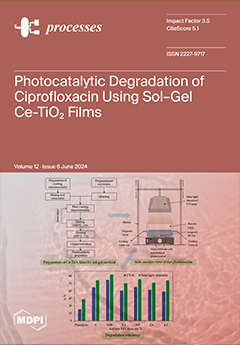There is a growing need for an economical and efficient method capable of removing heavy metals from residual water. The current contribution aimed to evaluate the capacity of onion peel, an abundant agroindustrial waste product, to remove divalent cobalt (Co
2+) from
[...] Read more.
There is a growing need for an economical and efficient method capable of removing heavy metals from residual water. The current contribution aimed to evaluate the capacity of onion peel, an abundant agroindustrial waste product, to remove divalent cobalt (Co
2+) from aqueous solutions. Onion peel was submitted to proximal chemical analysis, and various operational factors involved in biosorption were tested. The most suitable temperature (30 °C), pH (7.0), and biosorbent particle size (300–800 µm) were found. With an initial Co
2+ concentration of 380 mg L
−1, the maximum capacity of Co
2+ removal was 59.88 mg g
−1 in 120 min. The pseudo-second order and Langmuir models provided the best fit to the experimental kinetics and equilibrium of Co
2+ biosorption, respectively. The thermodynamic study evidenced an exothermic, non-spontaneous, and favorable reaction (Δ
H0 = −5.78 kJ mol
−1; Δ
S0 = −21.13 J mol
−1 K
−1), suggesting the formation of stable bonds in the biosorbent-Co
2+ complex. The carbonyl and hydroxyl groups apparently play a fundamental role in Co
2+ removal, and electrostatic attraction, ion exchange, and chemisorption are the principal mechanisms. Thus, the biosorption of Co
2+ by onion peel has potential as an economical, eco-friendly, efficient, and sustainable treatment for wastewater.
Full article





